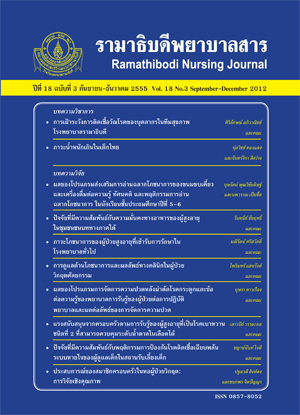ผลของโปรแกรมการบริหารแขนและไหล่ต่อความสามารถในการบริหาร และภาวะแทรกซ้อนหลังผ่าตัดในผู้ป่วยมะเร็งเต้านมที่ได้รับการผ่าตัด
Main Article Content
Abstract
บทคัดย่อ
การศึกษาครั้งนี้มีวัตถุประสงค์เพื่อศึกษาผลของโปรแกรมการบริหารแขนและไหล่ ต่อความสามารถในการบริหารแขนและไหล่ และภาวะแทรกซ้อนหลังผ่าตัดในผู้ป่วยมะเร็งเต้านม ที่ได้รับการผ่าตัด กลุ่มตัวอย่าง คือ ผู้ป่วยมะเร็งเต้านมที่ได้รับการผ่าตัด จำนวน 51 ราย เครื่อง มือวิจัยประกอบด้วย 1) โปรแกรมการบริหารแขนและไหล่สำหรับผู้ป่วยมะเร็งเต้านมที่ได้รับ การผ่าตัด และ 2) เครื่องมือที่ใช้เก็บรวบรวมข้อมูล ได้แก่ แบบบันทึกข้อมูลส่วนบุคคล แบบ ประเมินองศาการเคลื่อนไหวของข้อไหล่ แบบประเมินภาวะแขนบวม แบบประเมินความ สามารถในการปฏิบัติตามการบริหารแขนและไหล่ และแบบประเมินการทำหน้าที่ของแขนและ ไหล่ การเก็บรวบรวมข้อมูลแบ่งเป็น 3 ระยะ ได้แก่ ระยะก่อนผ่าตัด 1 วัน หลังผ่าตัด 1 สัปดาห์ และหลังผ่าตัด 1 เดือน ผลการศึกษาพบว่า ความสามารถในการบริหารแขนและไหล่ก่อนผ่าตัด 1 วัน หลังผ่าตัด 1 สัปดาห์ และหลังผ่าตัด 1 เดือนแตกต่างกันอย่างมีนัยสำคัญทางสถิติ ความ สามารถในการบริหารแขนและไหล่มีความสัมพันธ์กับการจำกัดการเคลื่อนไหวของแขนและไหล่ อย่างมีนัยสำคัญทางสถิติ แต่ไม่มีความสัมพันธ์กับภาวะแขนบวม ความสามารถในการทำหน้าที่ ของแขนและไหล่ก่อนผ่าตัด 1 วันกับหลังผ่าตัด 1 เดือนไม่แตกต่างกันอย่างมีนัยสำคัญทางสถิติ ผลการศึกษานี้แสดงให้เห็นถึงความสำคัญของการบริหารแขนและไหล่ที่ช่วยป้องกันและ ลดปัญหาการเกิดการจำกัดการเคลื่อนไหวของแขนและไหล่ และช่วยเพิ่มความสามารถในการ ทำหน้าที่ของแขนและไหล่ให้กลับมาเป็นปกติเหมือนก่อนผ่าตัด ดังนั้น จึงควรนำโปรแกรมการ บริหารแขนและไหล่มาใช้ในผู้ป่วยมะเร็งเต้านมที่ได้รับการผ่าตัดเพื่อเป็นประโยชน์ในการฟื้นฟู สภาพหลังผ่าตัดและยังเป็นการป้องกันการจำกัดการเคลื่อนไหวของแขนและไหล่ภายหลังการ ผ่าตัดที่มีประสิทธิภาพ
คำสำคัญ : โปรแกรมการบริหารแขนและไหล่, มะเร็งเต้านม, การจำกัดการเคลื่อนไหวของแขน และไหล่, แขนบวม
Abstract
This research aimed to examine the effects of a shoulder and joint exercise program on the ability to exercise and post-operative complications in breast cancer patients undergoing surgery. The sample consisted of 51 breast cancer patients who had undergone breast surgery. The research instruments consisted of a shoulder and joint exercise program. Data collection included the Demographic Data Collection Form, the Range of Motion of Shoulder and Joint Assessment Form, Lymphedema Assessment Form, the Ability to Do Shoulder and Joint Exercise the Assessment Form, and the Arm and Shoulder Functions Assessment Form. There were 3 phases of data collection: one day before surgery, one week after surgery, and one month after surgery. The results revealed that the abilities to do shoulder and joint exercise during the one day before surgery, one week after surgery, and one month after surgery were statistically different. The shoulder and joint exercise abilities were statistically related to a limitation in the shoulder and joint motion; however, they were not related to arm lymphedema. Furthermore, the shoulder and joint functions between one day before surgery and one month after surgery were not statistically different. The findings also indicated that the shoulder and joint exercise program was important to prevent and reduce the limitation of shoulder and joint motion, as well as contribute to normal shoulder and joint function in breast cancer patients undergoing surgery. Therefore, it is suggested that the shoulder and joint exercise program should be applied to breast cancer patients who had undergone surgery in order to prevent limitation of shoulder and joint motion after surgery.
Keywords : Shoulder and joint exercise program, Breast cancer, Limitation of shoulder and joint motion, Arm lymphedema
Article Details
บทความ ข้อมูล เนื้อหา รูปภาพ ฯลฯ ที่ได้รับการตีพิมพ์ในรามาธิบดีพยาบาลสาร ถือเป็นลิขสิทธิ์ของวารสาร หากบุคคลหรือหน่วยงานใดต้องการนำทั้งหมดหรือส่วนหนึ่งส่วนใดไปเผยแพร่หรือเพื่อกระทำการใด ใด จะต้องได้รับอนุญาตเป็นลายลักษณ์อักษรจากรามาธิบดีพยาบาลสารก่อนเท่านั้น


